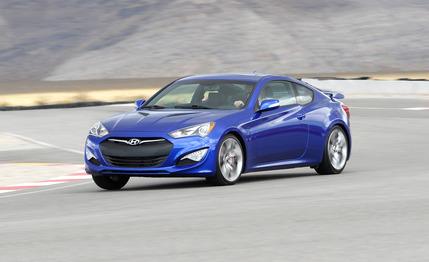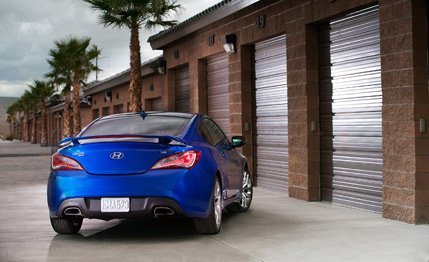
 First Drive Review
First Drive Review
According to Hyundai America CEO John Krafcik, 2011 marked the highest calendar-year sales ever for the Genesis coupe. The self-confessed factoid freak calmly references this fact from the passenger seat of a 2013 Genesis coupe as we skim across the Nevada Desert floor at speeds well over the century mark. Krafcik is busy peppering me with questions about the car—and other cars, and Apple, Sony, BlackBerry, and the current state of EPA regulations, among other topical concerns—and snapping photos when we roll over a cattle grate without drama; doing so in the pre-refresh Genesis coupe would have sent reverberations throughout the entire car. He smiles approvingly, then returns his attention to his BlackBerry and begins hammering out another series of messages. Note to Genesis coupe suspension engineers: Now may be the time to ask for a raise.
We gave you a look at the Genesis’s revised fascia when it debuted at the Detroit show back in January, and we can now confirm our suspicion that the hood is an entirely new stamping, a costly proposition for a simple midlife revamp. Paintwork on the dozen or so examples we examined was flawless, and the Genesis looks light-years better—and bigger—in the flesh than in photographs. But the real news is the pair of significantly reworked engines residing under that fresh hood.
Drivetrain à la Carte
The all-aluminum 2.0-liter four-cylinder now utilizes a twin-scroll turbocharger and a 53-percent-larger intercooler to produce a formidable 274 hp and 275 lb-ft of torque, up 64 hp and 52 lb-ft over the outgoing engine. Aided by the new twin-scroll turbo and dual continuously variable valve timing, maximum torque arrives at 2000 rpm, and the car pulls hard out of corners with minimal turbo lag. Engine NVH levels are improved from before. Hyundai engineers point to a new stainless-steel integrated exhaust manifold and the integrated turbo housing that weighs less and dissipates heat more efficiently while also improving efficiency and emissions. The waste gate is now electronically controlled for more accurate boost modulation and improved mid- and high-load fuel efficiency. Under hard throttle, the exhaust emits a mild midrange honk that climbs in pitch with acceleration. Outside of the car the tone is even more raucous, and should be music to the ears of any remaining members of the Fast and Furious club.


If the 2.0T is the feisty extrovert, then the direct-injected V-6 is the strong, silent type. With 348 hp on tap, the V-6 Genesis edges out a couple of class-above coupes, the 330-horse Infiniti G37 and the 300-hp BMW 335i. Its 295 lb-ft of torque tops the G37’s 270 and gives up a scant 5 lb-ft to the 335i. More direct competition comes via the Nissan 370Z and the Ford Mustang, two rear-drive stalwarts in the same general price range. The former offers 332 hp as standard or 350 in NISMO trim, while the latter serves up 43 fewer horsepower than the Genesis V-6 but also offers 412 hp from its 5.0-liter V-8.
At idle, the Genesis’s V-6 remains smooth and steady, and revs climb willingly with a blip of the throttle. Although its peak torque doesn’t arrive until 5300 rpm, the engine is strong from 2000 rpm in almost any gear. On the highway, 2000 rpm in sixth gear motivates the Genesis along at a dash-indicated 70 mph. Floor it, and the comparatively mature exhaust note improves as engine speed climbs. Krafcik commented that getting a sweet sound under acceleration was easy, though; finding an acceptable tone at idle proved to be the hard part, the process apparently complicated by the engine’s direct injection. Note that the V-6 does employ an intake sound-induction tube to route some “car noise” into the otherwise serene cabin.
Top speed is limited to 146 mph for the 2.0T and 149 for the 3.8. Knock sensors are employed to allow both engines to run on regular unleaded fuel—albeit with a small power deficit—when drivers don’t feel like paying the premium for premium. Hyundai claims the mileage figures are the same with either fuel.
Transmission availability isn’t as simple as just choosing a trim and then opting for a manual or automatic. Both the 2.0T and 3.8 Genesis R-Spec models come only with the six-speed manual; the 3.8 Grand Touring and 2.0T Premium are available with only the newly available eight-speed automatic; and the base 2.0T and the 3.8 Track models can be equipped with either transmission. The eight-speed automatic (gears seven and eight are overdrives) is the first octo-cog in the class. R-Spec and Track models have an available Torsen limited-slip differential.